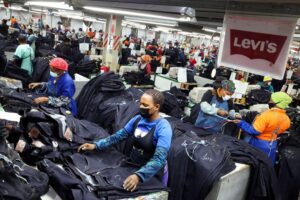It’s more than half a year into the coronavirus pandemic and Amalia Hernandez de Ramirez hasn’t been sleeping well.
“ ‘Sometimes I wake up in the middle of the night thinking about this and it’s hard to go back to sleep, how I’m going to make it through.’ ”
“Sometimes I wake up in the middle of the night thinking about this and it’s hard to go back to sleep, how I’m going to make it through,” she told MarketWatch through a Spanish-language interpreter. “It really wears me down.”
What’s keeping the 57-year-old Albuquerque, N.M. woman awake are worries about partially paid bills, whether she can buy all the groceries she needs, and the new reality of her biweekly paycheck, which shrank from $1,500 before the pandemic to $800.
In a grim way, she’s lucky.
That’s because Hernandez de Ramirez is at least making some income in the especially hard-hit domestic worker sector. She supervises caregivers for senior citizens in the cooperative care organization she helped found. She used to manage 20 people. Now it’s 12.

Amalia Hernandez de Ramirez of Albuquerque, N.M. has seen her paycheck shrink from $1,500 to $800 — but she’s faring better than many domestic workers.
Before COVID-19 struck, 9% of domestic workers didn’t have any jobs lined up in a week, according to a new National Domestic Workers Alliance survey of more than 20,000 Spanish-speaking house cleaners, nannies and home-care workers.
Then came the pandemic, along with shutdown orders and social distancing efforts that kept families at home and crimped demand for caregiving and cleaning.
As of late September, 36% to the polled workers were jobless, according to the survey. That’s an improvement from the 68% without work in early May. Most of the participants are mothers of school-age children or younger, the report noted.
More than half of the surveyed workers couldn’t pay their rent or mortgage from April through September. Around two-thirds of the workers didn’t get a stimulus check and the large majority (86%) didn’t apply for unemployment insurance of as June. For those that did, 43% ended up getting the benefits.
Hernandez de Ramirez earned a little too much to qualify for unemployment benefits in her state, and that locked her out of the $600 weekly supplemental benefits under the $2.2 trillion CARES act.
Hernandez de Ramirez and her husband received stimulus checks, as well as her daughter. Her son is still waiting on his.
“ ‘It is now a full-blown depression for domestic workers.’ ”
“It is now a full-blown depression for domestic workers,” said Ai-jen Poo, co-founder and executive director of the National Domestic Workers Alliance, a nonprofit advocacy organization.
The country’s estimated 2.5 million domestic workers include some of the fastest-growing jobs in the country, she said, but they are some of the least lucrative.
Home health care aide jobs will grow by 34% more than average job growth through 2029, according to the Bureau of Labor Statistics. The median pay is almost $25,300 a year.
“Our economy is simply not working for domestic workers,” Poo said.
Domestic workers and the ‘she-cession’
The economy is not working for many women right now, data suggests. So much so, that some observers are calling this a “she-cession.”
Woman have been losing more jobs than men since the pandemic’s onset, according to the Center for American Progress, a left-leaning think tank. From February to April, woman lost 12.1 million jobs while men lost roughly 10 million, researchers said, looking through Bureau of Labor Statistics numbers.
“ From February to April, woman lost 12.1 million jobs while men lost roughly 10 million, researchers said. ”
One big reason is the service sector — a spot of the economy where many jobs are premised on in-person interactions — has been disproportionately hit during the outbreak.
The sector employs more women than men, researchers noted. Another reason is women still perform the majority of unpaid child care, and many dropped out to handle the prospect of remote schooling and disrupted child care arrangements.
Talks for a stimulus deal before Election Day have now collapsed. But back in August, the domestic worker survey asked participants to rank what should be in a relief package.
The top priority was free COVID-19 testing and treatment regardless of immigration status. Access to child care help was a near second, the report said.
The consequence of pay that’s ‘off the books’
Most of the surveyed domestic workers who didn’t apply for unemployment benefits said they didn’t bother trying because they didn’t think they would qualify.
Undocumented workers are not eligible for unemployment benefits, but people with a work authorization can collect benefits, according to the National Employment Law Project.
The domestic worker survey purposely didn’t collect information on status because questions were conducted via social media, where privacy policies were beyond pollsters’ control. Still, researchers said it was “reasonable to conclude that a significant percentage of our survey respondents” were foreign-born documented and undocumented workers.
But another complicating factor could be the informal “off the books” pay arrangements where workers get cash or payments via apps and have no pay stubs to demonstrate their earnings.
‘I feel very uncertain. I don’t know what the future brings.’
One New York City nanny, “V.C.”, is one example.
During the nanny’s seven and a half years with one family, she was paid with cash, checks and apps. In March, the family moved two and a half hours upstate and asked V.C. to come with her. (The nanny did not want to be identified for privacy reasons and in order to avoid jeopardizing her future job prospects.)
The family’s request was a tough ask for a woman who had aging family members in Queens. She applied for unemployment in April and received her first check in September.
It was a long wait for a woman who’s still looking for new employment. “I was very jittery, very nervous and didn’t know what to do,” V.C. told MarketWatch.
In normal times, state labor officials might have processed a case like V.C.’s in two to three weeks, according to Victor Brito, a senior paralegal at Legal Services NYC who handled V.C.’s case. That’s the time to review earnings documentation, which can include PayPal data, he said.
During the pandemic, the turnaround time has been three to four months. “Meanwhile, the claimants are still getting credit card bills and still have to put food on the table,” Brito said.
V.C. has been looking for new jobs but many openings are for live-in nannies, which won’t work for her. “I feel very uncertain, I don’t know what the future brings.”
‘It’s largely popping back for highly-educated nannies’
Many caregivers are falling through the cracks of the formal temporary safety nets arranged by government, so they are creating their own.
The Nanny Relief Fund popped up in the spring, powered by some company donations and small dollar donations from nannies. In June, the fund disbursed 80 $500 grants to nannies, said Rachael Lubin, a founding board member with the idea for the fund and a nanny herself. Some recipients said they used the money for bills and back rent, Lubin said.
“ ‘Even the jobs that have come back have come back for those that likely were not struggling anyway.’ ”
The organization, which is applying for nonprofit status, is eyeing another round of fundraising next month, said Lubin, who is also on the board of the International Nanny Association, an umbrella group for the in-home child care industry.
Demand for nannies revived in August, as parents planned for care and assistance with a remote school year starting for many, Lubin said.
“The industry is popping back, but it’s largely popping back for highly-educated nannies” who can double as tutors and teachers, Lubin said. “Even the jobs that have come back have come back for those that likely were not struggling anyway.”
Back in New Mexico, so much has changed for Hernandez de Ramirez since March. But one thing hasn’t: the wear that comes with managing her finances and eking out hours for herself and her staff.
“Things are going the same since those early scary days … We’re still really anxious and worried about our health and protecting others,” she said.





